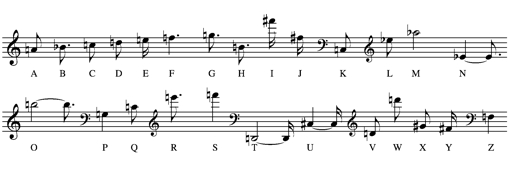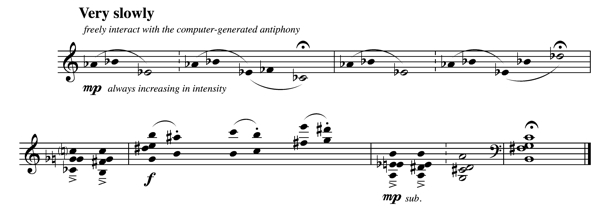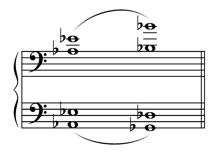the language of the angels
I. Whether one angel talks to another
II. Whether a lower angel speaks to a higher one
III. Whether an angel talks to God
IV. Whether distance has any effect on the angels's speech &
Whether all the angels know what one says to another
The Language of the Angels was inspired by Olivier Messiaen’s invention of a communicable language. The privileged wordless communication of angelic speech described by Saint Thomas Aquinas in the Summa Theologica (c1265-1274) was Messiaen’s source of inspiration for the playful invention of a musical alphabet for his solo organ cycle Médiations sur le Mystère de la Sainte Trinité (1969). This alphabet of sounds, in which each letter of the alphabet is mapped to a specific pitch and duration, allowed Messiaen to transcribe words into music (Messiaen 1973).

Fig. 1. Messiaen's musical alphabet.
It serves as the core element in his vivid musical depictions of angelic communication. Aquinas describes the speech of the angels in the five articles of question 107 of the Summa Theologica (Aquinas 1947). The first movement is a musical depiction of the first article. It features algorithmically-generated antiphonal exchanges on the following theme (Fig. 2).

Fig. 2. The improvisatory framework for the first movement.
The second movement, which is based on the second article, introduces the main theme of the work–an ostinato figure that, like the material in the first movement, is subjected to algorithmically-generated antiphonal exchanges.

Fig. 3. The main theme.
Whereas the first two movements feature the performer playing in a traditional manner on a synthesizer keyboard, the third movement is performed solely on a computer keyboard. An algorithmic implementation of Messiaen’s communicable language allows the performer to type word selections from the third article on the computer keyboard and have these improvisations immediately turned into the music. The fourth and final movement is a depiction of the fourth and fifth articles. It recapitulates and combines musical elements from the three previous movements.
The work is dedicated to my composition teacher Alan Stout who introduced me to Messiaen's strange and wonderful communicable language.
RB
references
Aquinas, Thomas, 1947. "The Speech of Angels (Five Articles)," from Summa Theologica,
trans. by The Fathers of the English Dominican Province.
http://www.sacred-texts.com/chr/aquinas/summa/sum118.htm
Messiaen, Olivier, 1973. Liner notes to Messiaen’s Méditations sur le Mystère de la Sainte Trinité
pour orgue, Almut Rößler, organ (Schwann-Studio 702/703).
Updated: January 12, 2012